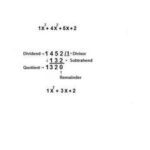When raising a binomial to the second power, we use the FOIL method. We can raise a binomial to the 3rd power by using the FOIL method and then multiply the result by the original binomial. As we raise a binomial to higher powers, this method gets increasingly tedious and time consuming. The binomial theorem allows us to expand these binomial expressions much more easily. Before we learn the binomial theorem, we must learn about binomial coefficient.
A binomial coefficient read ” n above r ” or ” n choose r ” for non-negative integers n and r where n ≥ r is defined as n!/[r!(n-r)!]. The symbol nCr is often used to denote binomial coefficients. Recall that n ! = n ( n – 1)( n – 2)( n – 3)……1, so 4! = 4(3)(2)(1). When we evaluate binomial expressions raised to a power, there is a pattern that develops. For example, we take the binomial expression ( x + y ) and raise it to the n th power, where n = 1, 2, 3, ……
(x + y)^1 = x + y
(x + y)^2 = x^2 + xy + xy + y^2 = x^2 + 2xy + y^2
(x + y )^ 3 = ( x + y )^ 2 ( x + y ) = ( x^ 2 + 2 xy + y^ 2 )( x + y ) = x^ 3 + ( x^ 2) y + (2 x^ 2) y + 2 xy^ 2 + ( y^ 2) x + y^ 3 = x^ 3 + (3 x^ 2) y + 3 xy^ 2 + y^ 3
(x + y )^ 4 = ( x + y )^ 3 ( x + y ) = ( x^ 3 + (3 x^ 2) y + 3 xy^ 2 + y^ 3 )( x + y ) = x^ 4 + ( x^ 3) y + (3 x^ 3) y + (3 x^ 2) y^ 2 + (3 x^ 2) y^ 2 + 3 xy^ 3 + ( y^ 3) x + y^ 4 = x^ 4 + (4 x^ 3) y + (6 x^ 2) y^ 2 + 4 xy^ 3 + y^ 4
Notice that the expansion of each of the binomials is a polynomial. Some patterns observed are as follows:
1. Each expansion begins with the term x^n.
2. The exponents on x decrease by 1 with each term.
3. The exponents on y begin with 0. Since y^0 = 1, there is no y in the first term.
4. The exponents on y increase by 1 with each term.
5. The sum of the exponents on any term always equals n.
6. The number of terms is always 1 more than n.
Let’s illustrate the preceding 6 patterns with the expansion of (x + y)^3 = x^3 + (3x^2)y + 3xy^2 + y^3.
1. The first term is x^3. Since n = 3, it holds true that x^n = x^3.
2. The exponents for x on the next terms are 2,1, and 0, which holds true that the exponents for x decrease by 1 each term.
3. The is no y in the first term, therefore it holds true that the exponents for y start at 0, since y^0 = 1.
4. The exponents for y in the next terms are 1,2, and 3, which holds true that the exponents for y increase by 1 each term.
5. The sum of the exponents per term are as follows, 3 + 0 = 1, 2 + 1 = 3, 1 + 2 = 3 and 0 + 3 = 3. Since n = 3, it holds true that the sum of the exponents of any term equals n.
6. There are 4 terms in the expression, therefore it holds true that the number of terms is 1 more than n.
We demonstrated the pattern in the variable part of the binomial expansions. We us binomial coefficients with the pattern to come up with the binomial theorem, which is used to expand binomial expressions, given the power of the binomial is positive.
The binomial theorem is as follows:
(x + y)^n = nCo(x^n) + nC1(x^(n-1))y + nC2(x^(n-2)y^2) + nC3(x^(n-3)y^3)+…..+ nCn(y^n), where
For example, expand (x + 5)^4 using the binomial theorem.
(x + 5)^4 = 4C0(x^4) + 4C1(x^3)(5) + 4C2(x^2)(5^2) + 4C3(x)(5^3) + 4C4(5^4)
(x + 5)^4 = x^4 + 20x^3 + 150x^2 + 500x + 625.
It’s clear that knowing and using the binomial theorem is a more convenient way to simplify binomial expressions when the exponent of the binomial is positive and greater then 2. Try using it a few times and you’ll never want to expand binomials any other way.




